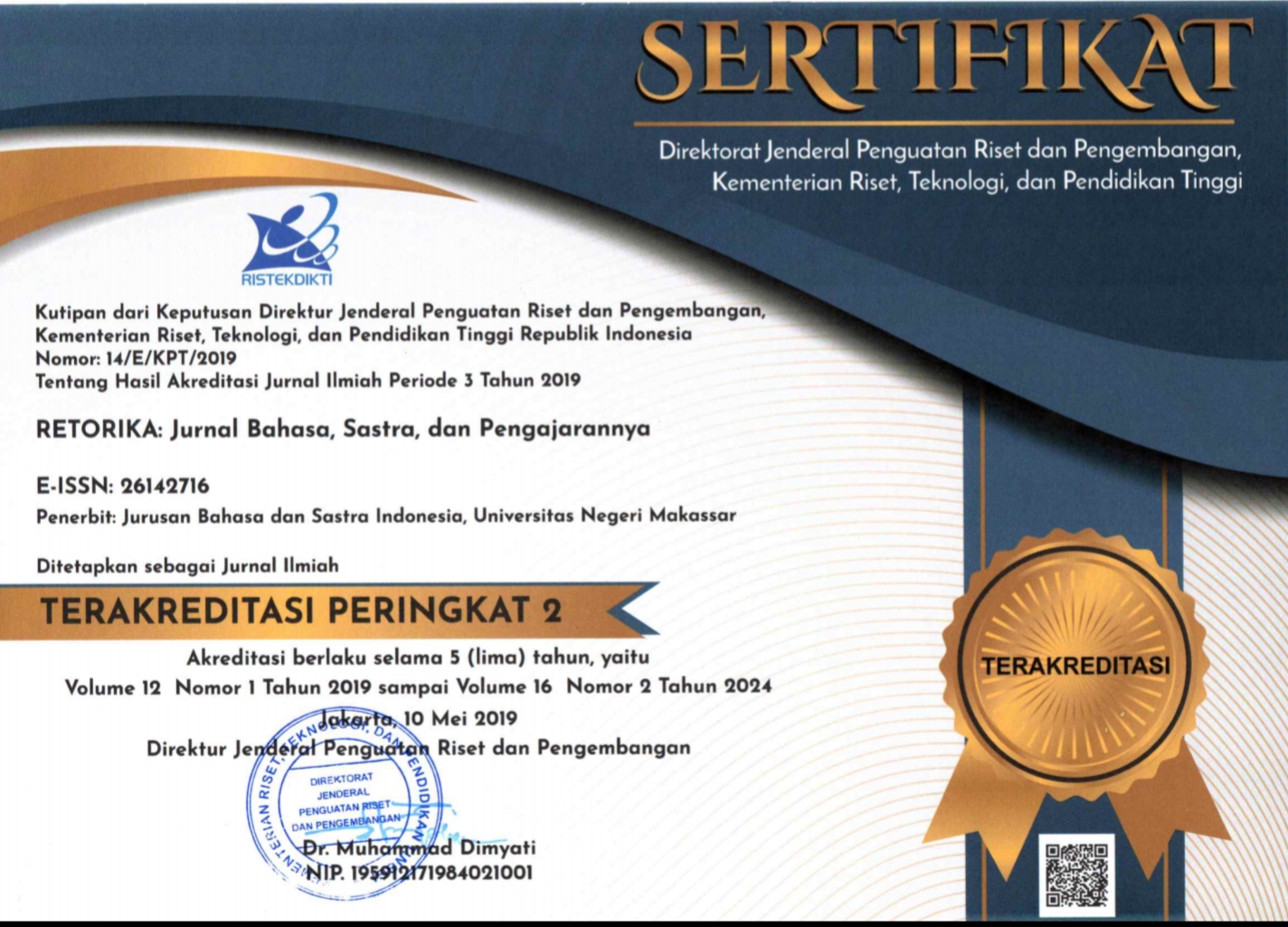THE ROLE OF CONTEXT IN THE INTERPRETATION OF PRAGMATIC MEANING
(1) Program Magister Pendidikan Bahasa dan Sastra Indonesia, FKIP, Universitas Sanata Dharma, Yogyakarta
(*) Corresponding Author
DOI: https://doi.org/10.26858/retorika.v13i2.12666
Abstract
This article entitled "The Role of Context in Interpreting Pragmatic Meanings" aims to find the role of contexts in interpreting pragmatic meanings. The study is a literature review that is interpretive in nature. Data collection techniques are done by reviewing the work of the experts to map the author’s perspective on the context. The steps of the analysis are identifying the theories being reviewed, classifying the results of the identification, interpreting the results of the review, and writing a journal article. The findings of the study include 11 aspects of context to determine pragmatic meanings. Based on the findings, it can be discussed that the semantic meaning is different from the pragmatic meaning because the pragmatic meaning always depends on the context. On the basis of these findings, it can be concluded that the pragmatic meaning is determined by the extralingual contexts.
Keywords
Full Text:
PDFReferences
Brown, G., Yule, G., Brown, G., & Yule, G. (2013). Introduction: linguistic forms and functions. In Discourse Analysis. https://doi.org/10.1017/cbo9780511805226.003.
Cook, G. (2003). Applied Linguistics (Oxford Introduction to Language Study Series). Oxfords.
Dash, N. S. (2008). Context and Contextual Word Meaning. SKSE Journal of Theoretical Linguistic, 21–31.
Dey, A. K. (2017). Malware originated HTTP traffic detection utilizing cluster appearance ratio. International Conference on Information Networking, 248–253. https://doi.org/10.1109/ICOIN.2017.7899513.
Dijk, T. A. Van. (2009). Context Theory and the Foundation of Pragmatics. Nihongoyouron Gakkai, 10, 1–13.
Hu, X. (2014). Context : from static to dynamic. 2(2), 127–133. https://doi.org/10.11648/j.ijll.20140202.21.
Korta, K. (2008). Malinowski and pragmatics. Claim making in the history of linguistics. Journal of Pragmatics, 40(10), 1645–1660. https://doi.org/10.1016/j.pragma.2007.12.006.
Miller, D. I., Eagly, A. H., & Linn, M. C. (2015). Women’s representation in science predicts national gender-science stereotypes: Evidence from 66 nations. Journal of Educational Psychology, 107(3), 631–644. https://doi.org/10.1037/edu0000005.
Porayska-pomsta, K., Mellish, C., Pain, H., Eugenio, B. Di, & Moore, J. D. (2000). Pragmatic Analysis of Teachers ’ Language . Towards an Empirically Based Approach . Pain.
Pranowo. (2016). Unsur Intralingual Dan Ekstralingual Sebagai Penanda Daya Bahasa Dan Nilai Rasa Bahasa Dalam Kesantunan Berkomunikasi. Adabiyyāt: Jurnal Bahasa Dan Sastra. https://doi.org/10.14421/ajbs.2015.14202.
Pranowo. (2019). Wujud dan Makna Pragmatik Bahasa Nonverbal Dalam Komunikasi Masyarakat Jawa: Kajian Etnopragmatik. Linguistik Indonesia, 37(2), 169–184. https://doi.org/10.26499/li.v37i2.111.
Rahardi, K. (2009). Sosiopragmatik. Yogyakarta: PT Gelora Aksara Pratama.
Santschi, E. M., Williams, J. M., Morgan, J. W., Johnson, C. R., Bertone, A. L., & Juzwiak, J. S.(2015). Preliminary Investigation of the Treatment of Equine Medial Femoral Condylar Subchondral Cystic Lesions With a Transcondylar Screw. Veterinary Surgery, 44(3), 281–288. https://doi.org/10.1111/j.1532-950X.2014.12199.x.
Shen, L. (2012). Context and Text. Theory and Practice in Language Studies. https://doi.org/10.4304/tpls.2.12.2663-2669.
Song, L. (2010). The Role of Context in Discourse Analysis. Journal of Language Teaching and Research, 1 no 6.
Song, L. 2011. The Role of Context in Discourse Analysis. Journal of Language Teaching and Research. https://doi.org/10.4304/jltr.1.6.876-879.
Verhagen, A. 1977. Context, Meaning, and Interpretation in a practical approach to linguistics.
Widdowson, H. G. 1989. Knowledge of Language and Ability for Use. Applied Linguistics 10.
Yusny, R. 2013. Appropriatizing Politeness Theory for Intercultural Communication in Elt. Jurnal Ilmiah Didaktika, 14(1), 176–189. https://doi.org/10.22373/jid.v14i1.496
Article Metrics
Abstract view : 4073 times | PDF view : 466 timesRefbacks
- There are currently no refbacks.
Copyright (c) 2020 Pranowo Pranowo

This work is licensed under a Creative Commons Attribution-NonCommercial 4.0 International License.
Published by:
Department of Indonesian Language, Faculty of Languages and Literature, Universitas Negeri Makassar in cooperate with Asosiasi Dosen Bahasa dan Sastra Indonesia (ADOBSI) and Ikatan Program Studi Pendidikan Bahasa dan Sastra Indonesia (IKAPROBSI).
Address: Department of Indonesian Language Office, DG Building Second Floor, UNM Parangtambung, Daeng Tata Raya Street, Makassar, South Sulawesi, Indonesia
 Email: [email protected]
Email: [email protected]

RETORIKA: Jurnal Bahasa, Sastra,dan Pengajarannya is licensed under a Creative Commons Attribution-NonCommercial 4.0 International License.
















